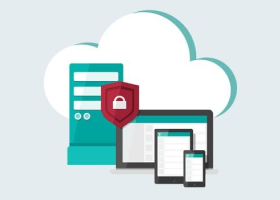Secure Enterprise File Sharing
Let’s jump in and learn:
- What Is Enterprise File Sharing?
- Examples of How Secure Remote File Access Is Used
- 5 Things to Consider While Evaluating an Enterprise File Sharing Solution
- What Is Enterprise File System?
- What are the Two Types of File Sharing?
- Enterprise File Sharing with Maximum Security and Compliance
- Enterprise File Sharing Should Be Considered Mandatory for All Organizations
What Is Enterprise File Sharing?
Enterprise file sharing, also referred to as enterprise file sync and sharing (EFSS), is a service that allows files to be saved in cloud or on-premises storage and then be securely accessed by authorized users from any device anywhere. With enterprise file sharing, files are stored in a secure central location where they can be used by individuals and shared amongst teams and partners to facilitate collaboration.
Traditional file sharing encompasses the ability to transfer files between and synchronize files via the internet. This was made easier with cloud platforms, which enabled more robust functionality. These tools work well but fall short of the requirements for enterprise environments. Enterprise file sharing solutions provide file sync, sharing, and management along with sophisticated security constructs that allow users to safely access copies of files from their devices.

Enterprise file sharing systems take the contents of a folder, store copies in cloud storage systems, and distribute those copies to a user’s other devices. When a change is made to a file on one device, the enterprise file sharing system automatically distributes those changes, which is called syncing.
In terms of file share functionality, users can usually grant access rights to other users. Files can be shared by emailing, texting, or messaging a URL generated by the service. Lists of contacts are also created and maintained within an enterprise file sharing system. Users can also share file URLs by selecting from a list of contacts that appear in the system’s sharing options. According to permissions, users can then edit shared files and those changes are automatically saved and distributed to others with access to the file to ensure that everyone has the most current version.
Document workflows and collaboration capabilities are included in many enterprise file sharing solutions. This includes document management to ensure the secure exchange of internal and external (e.g., proposals, contracts, sales tools, employee records, performance reviews, training materials, marketing collateral, product information). Other features commonly included in enterprise file sharing systems are:
- Automated notifications to review and approve requests
- Legally binding e-signatures
- Version control to track document changes across multiple data sources and devices
- Workflow automation with feedback and approval processes as well as built-in co-authoring
With files subject to change by multiple users, there is the chance of issues with changes that are made. To address this, enterprise file sharing systems include file recovery features that allow users to restore files to previous versions and even recover lost files and folders. By maintaining a file history and taking snapshots of a given file over time, users to access older versions.
Access controls are a critical part of file sharing to ensure that organizations meet security and compliance requirements to minimize risks. Enterprise file sharing solutions use a number of security mechanisms to secure information, including:
- Authentication
- Data loss prevention
- Dey tracking
- Encryption (e.g., AES-256 encryption, email encryption)
- File scanning
- Identity access management
- Managed file transfer (MFT)
- SFTP secure connections
These security tools enhance security while detecting suspicious behavior, attempted data breaches, and unauthorized exfiltration transmissions.
Examples of How Secure Remote File Access Is Used
With the ubiquity of connected devices and the mass move of workforces to home offices, an organization’s workers are no longer sequestered to a single location using an internal network. Now, employees routinely connect to their internal network and access sensitive data from remote locations. Traditional access security systems are not designed to ensure secure access. A new breed of secure remote file access systems offers a mix of integrated technologies that give employees and other verified users access from anywhere, on any device, at any time—safely and securely.
Most of an organization’s users do work outside of offices. Secure remote file access helps workers who need to securely log in to a device or system that is connected to the organization's network in the office while working from a personal device at home. In some cases, managers use secure remote file access to find out what their employees are looking at on their company devices. IT personnel often use remote access to troubleshoot technical problems from afar.
5 Things to Consider While Evaluating an Enterprise File Sharing Solution
1. Data Protection and Security for Enterprise File Sharing
Data presents one of the most significant risks that an organization faces. All files need to be secured from vulnerabilities and protected from being lost or compromised. Enterprise file sharing solutions should include a rich suite of security features (e.g., encryption, access controls, antivirus scanning, data loss protection) to protect files at rest, in use, and in transit. Enterprise file sharing solutions should also provide robust sync and restore functionality. This is critical in the event that a file or folder is accidentally deleted, unwanted changes are made, and to meet compliance audit requirements. Other important features are the ability to remotely block or wipe devices in the event of loss or theft to prevent unauthorized access.
2. Enhanced Productivity and Collaboration with Enterprise File Sharing
One of the most common use cases for an enterprise file sharing system is to support collaboration, which translates into enhanced productivity. An enterprise file sharing system should allow users to securely share, sync, access, and edit files on any device in real-time. It should also include version control, online editing, check-in/out, and usage monitoring. In addition, users need to be able to share multiple files instantly in managed folders with role-based permissions and access controls.
3. Enterprise File Sharing for Data Governance and Compliance
Since most organizations generate and share confidential data within the organization, an enterprise file sharing system must address compliance needs. It should give provide a high level of data security and privacy, security controls, and comprehensive audit logs. An enterprise file sharing system should also allow for different file-sharing policies based on the varying levels of confidentiality or sensitivity of files based on tags.
4. Integration and Unified Administration Included with Enterprise File Sharing
An enterprise file sharing solution needs to provide a unified interface that can connect to any existing storage systems. It also needs to be able to seamlessly integrate with an organization’s existing applications and systems, such as threat prevention, data protection, and analytics solutions. In addition, an enterprise file sharing system should have a centralized admin portal for managing policies and monitoring file access across the organization.
5. Availability and Scalability
When evaluating enterprise file sharing systems, it is important to ensure that the storage structure and environment fit the requirements of the organization. For instance, the enterprise file sharing systems should be able to connect to multiple repositories, whether they are on-premises, cloud, or hybrid deployments as this is necessary to ensure scalability.
Several additional considerations while evaluating an enterprise file sharing solution are as follows.
- Automation
- Certifications and standards (e.g., ISO 27001, if security is a concern)
- Data control
- Delivery model flexibility
- Ease of use
- Migration support
- Performance and reliability
- Pricing structure
- Server locations
- Vendor lock-in
What Is Enterprise File System?
Enterprise file sharing systems are thought to be for large businesses—not so. Organizations of all sizes benefit from using an enterprise file sharing system, because most are searching for a way to securely transfer large files and need to collaborate, often from multiple locations. Tools that are commonly used for these purposes, do the job, but have significant security gaps. Enterprise file sharing systems provide the functionality that organizations need along with the security required to protect their digital assets and meet compliance standards that apply to most organizations regardless of their size.
An enterprise file sharing solution combines the accessibility and simplicity of a consumer file-sharing service with enhanced features that can improve productivity for users while increasing security, flexibility, and control over data. Several basic features included with enterprise file sharing solutions include:
- Access restrictions based on the network location
- Authorization policies
- Automation tools to schedule transfers and backups
- Collaboration capabilities, including live commenting, document version tracking, and workflow process management
- Complete visibility of data and access, including the location of data, how and when it is transmitted, and who is accessing it
- Enhanced security controls, such as:
- Containerization
- Data loss prevention
- Data protection
- Encryption
- File scanning
- Multi-factor authentication
- Single sign-on
- File expiration policies
- Granular access control
- Integration with enterprise directory services to simplify authentication and user provisioning
- On-premises or cloud storage options
- Passcode protection
- Real-time tracking and auditing of user activity
- Remote wipe and device locking
- Robust reporting tools to track usage and compliance
- Secure authentication protocols
- Support for large files or unique file extensions (i.e., file types that are used for specific applications or industries)
- Tools to handle file creation and editing (e.g., document management and creation, spreadsheet creation, video or audio streaming)
- Upload and download restrictions
- White/black listings
Among factors to consider before deploying an enterprise file sharing solution are the following.
- Whether to have a cloud or on-premises system for enterprise file sharing.
An on-premises approach will require upfront investment, it allows organizations to exert total control over their enterprise file sharing operations while providing users authorized access to files. Cloud enterprise file sharing solutions can provide the same security controls, but there are certain use cases where on-premises make more sense. - The level and breadth of mobility that are required by the enterprise file sharing system.
At a minimum, end users require that the enterprise file sharing solution will allow them to quickly access their files on smartphones, tablets, laptops, and desktop systems. It should also include file synchronization on the back-end server to update the file across all of a user’s devices. Advanced features include built-in viewers and notifications. - Management capabilities and security features included with the enterprise file sharing solution should be assessed.
An enterprise file management system should have a policy engine that helps organizations maintain tight control over their data. It should prevent unauthorized filesharing and revoke access if a device is lost or stolen. Additional security features are single sign-on support, multi-factor authentication, and permissions that can be used to restrict filesharing to trusted users or remotely wipe data from a device. It should also provide centralized management capabilities.
What are the Two Types of File Sharing?
There are two types of enterprise file sharing—operation system and the internet.
1. Operating system file sharing
File sharing capabilities are integrated into nearly every operating system.
- Can allow a user to access the file of other users by default, or require that a user specifically be granted access to the files
- Must maintain more file and directory attributes
- Owners are the user who may change attributes, grant access, and control the file or directory
2. Internet file sharing
There are several types of internet file sharing. Each serves a specific purpose. The most common internet file sharing approaches include the following
- Peer-to-peer (P2P) file sharing is a consumer-type technology in which each user’s device acts as a client in a bigger file sharing network. When a user accesses files from a network, the P2P software identifies where the data resides and then supports the download process. With P2P, direct sharing, files are sent directly from one device to another with no intermediary.
- Portal websites are used to allow users to share files and folders with co-workers and, in some cases, people residing outside of the organization via a shared link. These file sharing services provide real-time, collaborative access through a browser or mobile app.
- Sharing through a server allows users to upload their data to an internet-connected server. Once your data is stored on the server, it can be shared from there.
Enterprise File Sharing with Maximum Security and Compliance
Any enterprise file sharing solution must have capabilities to meet compliance requirements for various regulations. On-premises enterprise file sharing solutions give IT teams total control over how storage and security are managed.
For any file share activity that involves data leaving the confines of an organization’s corporate firewall, security is a major concern—especially for organizations subject to regulations, such as Health Insurance Portability and Accountability Act (HIPAA), the EU’s General Data Protection Regulation (GDPR), PCI-DSS.
Encryption is the most powerful tool in an enterprise file sharing system’s compliance arsenal. It protects data from potential attackers or unauthorized users. Most enterprise file sharing solutions also offer robust access management and offer integrations with Active Directory and other identity management and access control systems.
This helps to prevent data leaks and allows organizations to implement strong or customized authentication capabilities to manage access. It can also include single sign-on, multi-factor authentication, and data loss prevention (DLP) systems
Enterprise File Sharing Should Be Considered Mandatory for All Organizations
It is imperative that organizations provide enterprise file sharing services. Without them, users will find their own solutions and unsanctioned applications will proliferate, and IT teams will have no control over how data is being stored or shared. Worse, IT may not be aware of compromised data.
Organizations should select an enterprise file sharing solution based on its cost, security capabilities, management controls, user productivity features, and ability to easily integrate third-party tools and applications that are already in use.
There are many enterprise file sharing solutions available, organizations need to take heed of the risk of not implementing one. An enterprise file sharing solution not only mitigates risks, but provides a plethora of powerful benefits to users and IT teams.
Egnyte has experts ready to answer your questions. For more than a decade, Egnyte has helped more than 16,000 customers with millions of customers worldwide.
Last Updated: 5th April, 2023


